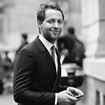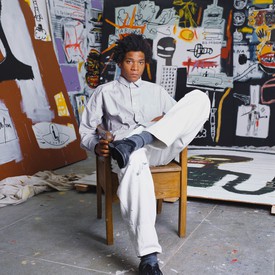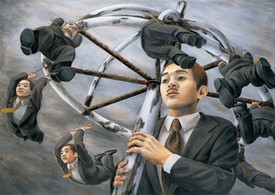
Derek Blasberg is a writer, fashion editor, and New York Times best-selling author. He has been with Gagosian since 2014, and is currently the executive editor of Gagosian Quarterly.
Derek BlasbergI’m told you’re participating in an architecture fair and in men’s fashion week. What gives?
Francesco VezzoliIn the case of the architecture fair, it’s not really a fair at all. It’s in Venice; it’s like the Documenta of Architecture. I was extremely flattered when Professor Martino Stierli invited me to the Monditalia section. And the fact that Rem Koolhaas is the director this year made me even more thrilled.
DBDescribe some of the works.
FVFor one piece, I acquired the sculpture of a female head from the second century AD, and I added two steel pieces to her eyes that look like self-reflecting contact lenses.
DBWhat inspired that?
FVWhen they invited me, they said they were making a study of the Roman villas, especially the ones in Capri. They said they liked my video about Caligula, so I figured that my contribution should be about the past, about looking backward as a way to see the future, which is what history is.
DBWould you consider yourself a fan of architecture? What did you think of this year’s selection?
FVI’ve seen most of the biennales in recent years. It’s just a great opportunity to get an overview of what the most prominent architects in the world are working on at the moment.
There’s a Botticelli “Birth of Venus” with Richard Gere from “American Gigolo” instead of the goddess. There is a “Saint Sebastian” by Mantegna with my own face and a tiny diamond bra.
Francesco Vezzoli
DBWhat’s Mr. Koolhaas like?
FVThe greatest game changer. It was he who decided that this fair, for the first time, should be more about the complexities of my country [Italy], and not just the usual suspects of architecture. He even decided to award the Golden Lion to a philanthropist, Phillys Lambert, rather than some architecture firm. I was literally in awe!
DBThat’s interesting. I do find that in architecture it’s the same names over and over, whereas in the art world there is some desire to seek fresh talent.
FVYes, but architecture is a practice that demands much higher budgets. So we mostly come across the names that have already earned enough stripes to merit big financial commitments from their clients.
DBThat’s a good point. Generally it’s easier for an artist to realize their idea than it is for an architect.
FVArt can still be made with nothing. Buildings cannot. But, you are right to seek new names, and what’s great about this biennale is that it proves that architecture is not just about buildings. I have found some original thoughts here too.
DBAnd what about the men’s fashion week in Florence?
FVIt’s the Pitti Uomo festival, which is one of Italy’s most prestigious men’s fashion presentations. They have invited designers from all over the world to participate for many years, and they’ve hosted some great art shows to coincide with the festival. Last year, they presented all the best projects that the Fondazione Nicola Trussardi had produced over the last decade, which I liked very much. This is the festival’s sixtieth anniversary, and they asked me to participate. I was invited by Francesco Bonami. How could I refuse?
we as human beings still want to participate in these social rituals, even though we do not necessarily need them.
Francesco Vezzoli
DBWhat is the concept, the theme? What can we expect?
FVThe themes are the history of art, and the ways in which we, as viewers, relate to it. I have chosen three amazing private museums, which are full of masterpieces from the Renaissance to the nineteenth century, and in each room I have installed one of my pieces. So it’s a bit like the game, “Where’s Waldo?” Most of the works are framed and installed so that it seems that they’ve always been there, which was fun and challenging at the same time. There’s a Botticelli Birth of Venus with Richard Gere from American Gigolo instead of the goddess. There is a Saint Sebastian by Mantegna with my own face and a tiny diamond bra. There’s a whole collection of Roman heads with silly hand-woven hats. There are Madonnas with the faces of Stephanie Seymour and Christie Brinkley. There are more pieces too, and they’re all mixed up with the real treasures from the Renaissance. Which I think is just hilarious.
DBThere are so many conventions nowadays: art fairs, architecture fairs, fashion weeks. Everyone says that the Internet keeps people sitting in front of computers, yet there are so many events like this now. Why is that?
FVMaybe it’s because we as human beings still want to participate in these social rituals, even though we do not necessarily need them. Or, maybe it’s because people hope to get laid at those events.
DBWow, I never thought about it like that. I guess there is a lot of sexual energy at these fairs. Sometimes I feel like Art Basel Miami is speed dating for art people.
FVThat is true: hundreds of artists, gallerists, artworks, celebrities—and they all flock to these fairs like moths to a flame. It’s just perfect for people who enjoy the scene. But for me, the politics that move them are completely incomprehensible and unfathomable. To be honest, I think some people see it merely as an opportunity to fill their Instagram profiles.
DBI know you’ve been to your fair share of fashion shows, in addition to art and architecture fairs. Do you prefer to go to art shows or to fashion shows?
FVThat’s easy. Fashion shows. For me, they are sheer fun. I attend three or four a year and I love them.
Artwork © Francesco Vezzoli












